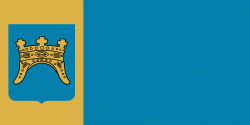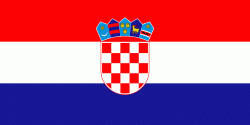Split-Dalmatia County (Split-Dalmatia)
 |
 |
Physically, the county is divided into three main parts: an elevated hinterland (Dalmatinska zagora) with numerous karst fields; a narrow coastal strip with high population density; and the islands. Parts of the Dinaric Alps, including Dinara itself, form the border with Bosnia and Herzegovina while the Kozjak, Mosor and Biokovo mountains separate the coastal strip from the hinterland.
Important economic activities include agriculture, manufacturing and fishing, though the most important one is tourism.
Split-Dalmatia County is Croatia's biggest county by area.
The county is linked to the rest of Croatia by the newly built four-lane Split-Zadar-Karlovac-Zagreb highway and the Lika railway. Split Airport is the busiest airport in the region.
In the hinterland, the larger towns are Sinj (pop. 11,500 town, 25,373 with villages), Imotski (4,350) and Vrgorac (2,200).
Besides the largest city, Split (189,000 city proper, 250,000 including Kaštela and Solin), the towns on the coast are Trogir (11,000), Omiš (6,500) and Makarska (13,400).
On the islands, the populations are smaller due to high levels of emigration, but are still mostly urban in character. The main townships are: Supetar (3,300) on the island of Brač; Hvar town (3,700) and Stari Grad (1,900) on Hvar; and Vis town (1,800) and Komiža (1,500) on Vis.
The name Dalmatia comes from an Illyrian tribe called the Dalmatae who inhabited the area of the eastern Adriatic coast in the 1st millennium BC. It was part of the Illyrian kingdom from the 4th century BC until the Illyrian Wars in the 220s BC and 168 BC when the Roman Republic established its protectorate south of the river Neretva. Dalmatia as a geographical name was in use probably from the second half of the 2nd century BC for the area spanning the eastern Adriatic coast between the Krka and Neretva rivers. It was slowly incorporated into Roman possessions until the province of Illyricum was formally established c. 32–27 BC.
Dalmatia became part of the Roman province of Illyricum. In 9 AD, the Dalmatians raised the final of a series of revolts together with the Pannonians, but it was finally crushed, and in 10 AD, Illyricum was split into two provinces, Pannonia and Dalmatia which spread into larger area inland to cover all of the Dinaric Alps and most of the eastern Adriatic coast. Dalmatia was the birthplace of the Roman Emperor Diocletian, who constructed Diocletian's Palace in the core of what is now Split.
Map - Split-Dalmatia County (Split-Dalmatia)
Map
Country - Croatia
Currency / Language
| ISO | Currency | Symbol | Significant figures |
|---|---|---|---|
| HRK | Croatian kuna | kn | 2 |
| ISO | Language |
|---|---|
| HR | Croatian language |
| SR | Serbian language |



















